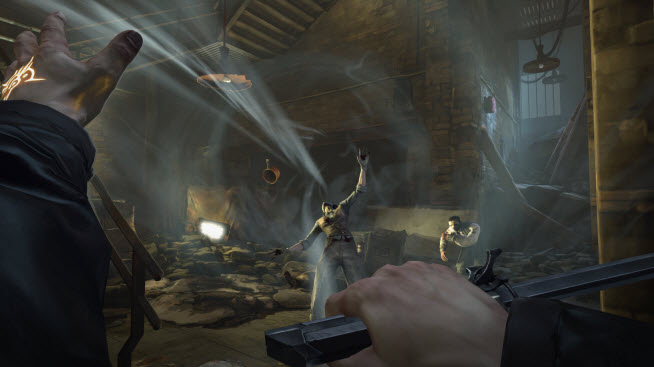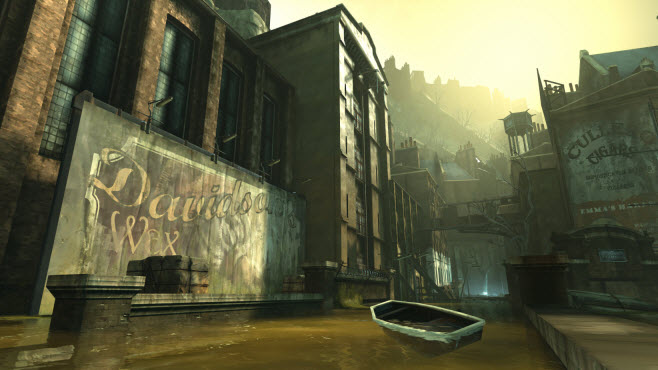Creating an original gaming world is hard. But when you do, the effect is memorable. That was the case with the makers of last year’s Deus Ex Human Revolution. They steered clear of the dull, gray, post-apocalyptic, sci-fi worlds and, after four years of work, created an orange-tinted universe that blends conspiracy theories and Blade Runner into something all together different.
For Dishonored, a new game from ZeniMax Media’s Arkane Studios, the challenge was similar. Three years ago, the team’s art directors began creating an original world that is finally being unveiled today. In a recent preview event in San Francisco, Calif., the art leaders (Viktor Antonov, visual design director of ZeniMax Media, and Sebastien Mitton, art director at Arkane Studios) described how they blended the style of Victorian-era London and steampunk science fiction novels to create Dunwall, the living world of Dishonored.
“We wanted to bring something special to this game,” Antonov said. “We decided to do a new world, a new metropolis, a new place. It doesn’t exist in video games, movies, or literature.”
The Londonesque part of this game is a smoggy, dark, and oppressive place. That makes sense since the artists are Parisians. When they walked around London, they saw brick buildings with steel pipes on the outside and barriers that stopped you from going places. They also visited Edinburgh and other cities in Scotland.
“London felt oppressive for a French man,” Mitton said. “The place is divided and controlled by fences. The parks are fenced off. There are signs that tell you what you can and can’t do.”
It reminded him of Terry Gilliam’s 1985 film, Brazil, and the dark, hypocritical society where buildings were menacing and walls were plastered with propaganda.
The art leads started working with story writers and concept artists. They recruited French traditional artists who drew, painted, and sculpted by hand. They also worked with production talent in Los Angeles, combining what they saw as the best of Paris and LA.
Antonov said that with Google Earth, we have few mysteries left on the planet. Every child can check out the world in minute, realistic detail. So Arkane decided to focus on stylistic art that looked like a place that doesn’t exist except in the imagination. That adds a sense of mystery to the game that we no longer have in the real world.
They set the game in a single city, but to make the world fully consistent, they had to build a whole continent, with a back story that explained, for instance, why foreigners visiting Dunwall might have a certain accent.
“That is about subtlety and precision,” Antonov said.

The focus was on creating a steampunk society, which is part of an anachronistic literary movement that combines sci-fi, fantasy, alternate history, horror, and speculative fiction. It often involves a setting that features steam power prominently, like in Britain in the Victorian era. Dunwall is a period piece — very Anglo-Saxon in the design of its mechanical devices and fashion. You can tell that tyrants rule Dunwall.
That sets up a contrast to the main character, who is a supernatural assassin who has mystical powers and comes from a very different kind of place.
While original, the world bears resemblance to other works. It draws inspiration from BioShock, a major video game that has an anachronistic underwater world dubbed Rapture. Metropolis and Blade Runner also inspired the team. The world reminded me of the setting of The Difference Engine, a novel set in Victorian Britain. That book describes the social change that occurs after inventor Charles Babbage creates the first mechanical computer. But the team said they had not thought about that connection.
“The hard thing about designing a nonexistent place is that it may not be appealing if it is too strange,” Antonov said. “So we had to strike a balance between accessibility and overall appeal and originality.”
Mitton started creating the elements of oppression, such as the prison, the gloomy castle, and the vehicles. It was hand-crafted rather than generated in a procedural way or through automated programming. They had to create familiar things, such as rail cars, but they made them different and fully functional. They created new kinds of horseless carriages that could plausibly work.
“As a vehicle designer, I got into suspensions and details and the personality of the machine,” Antonov said. “I created a whole new design language. This is a steampunk Victorian world, but it has no rivets, no brass, no copper, and no tubes. It has heritage and influences, but it is its own thing.”
The tough thing was that as the storyline and gameplay evolved, the team had to toss out some of the art they created. Sometimes the gameplay changed because of new ideas that came from the concept art.
The team didn’t actually build an entire city. Rather, they built out sections of the city in minute detail and left some areas unbuilt because they don’t enter into the story.
They had to make sure that even though the game was a period piece, it wasn’t “dusty and boring.” It is not a dark medieval world or a photorealistic world. The setting highlights the strong characters in the game, and those characters are dressed in unique Victorian fashion. They created unusual sculptures. They hired a teacher/painter who is known for hand-painting human faces to do the initial character designs. They created unique-looking weapons, such as a crossbow with a crank for loading bolts. They created mean-looking dogs and a weird-looking whaling ship in recognition that the economy of the city is based on whaling.
“When you are an artist and you have the opportunity to do something new, you go all the way,” Antonov said. “There are so many sequels in films and video games. We went to extremes and pushed ourselves.”
Check out the result for yourself in the video trailer below.
VentureBeat's mission is to be a digital town square for technical decision-makers to gain knowledge about transformative enterprise technology and transact. Learn More

